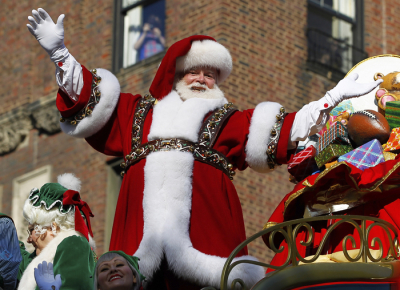Saint Nicholas and the origins of Santa Claus

It might surprise many today to find out that Saint Nicholas (spoiler alert) is a real person after all. Is he the white-bearded man with a red suit, a cap, and a sleigh?
Not quite, but he probably was bearded, did wear a hat, and did travel in horse-drawn, not reindeer-drawn, transportation. The legend behind Santa Claus is Saint Nicholas, the fourth-century bishop of Myra. His hat was the bishop's mitre.
Nicholas was born in modern-day Turkey to a rather wealthy family. Losing his parents at a young age, Nicholas dedicated both his fortune and his life to the Christian church. Very quickly he was appointed the bishop of Myra, on the southern coast of modern-day Turkey.
These were days of persecution for Christians. Roman Emperor Diocletian, who reigned from 284–305, hated Christians and stuffed Roman jails full of them. Bishop Nicholas spent the first few years of the fourth century in jail and faced routine beatings. In the next decade, Constantine legalized Christianity and Nicholas was set free.

As the legend goes, Bishop Nicholas was present at the Church’s First Ecumenical Council at Constantine’s summer palace in Nicea in 325. Hundreds of Bishops gathered there to refute the false views of Arius, a presbyter from Alexandria. Arius denied Christ’s deity. At one point while Arius was addressing the council, Nicholas’s rage got the better of him. According to some of his biographers, Nicholas stood up, crossed the floor to Arius, and promptly punched him in the face.
For the assault, Nicholas found himself back in jail again. The bishops deliberated his fate. Nicholas was repentant and sought forgiveness. After the Council, Constantine granted clemency and restored Bishop Nicholas to his post.
And at his post, Bishop Nicholas diligently served. Over the course of his entire life, he was known for being extremely generous. He was especially generous to children, regularly giving them gifts. Myra was a busy port city with ships and sailors coming and going. The ships went out of Myra’s port loaded with gifts and goods for the needy, all provided and packed by Bishop Nicholas. His gifts went all around the Mediterranean world. As sailors went around the world, they took with them the stories of the generosity of Bishop Nicholas.
The year of Bishop Nicholas’s death is uncertain, but the month is firmly believed to be December. As the story of his generosity spread, the stories of his life grew and grew. He was becoming legendary. In the sixth century, a church was dedicated to him and named for him in Constantinople. His image was depicted more in the Middle Ages than any other except those of Christ and of Mary. No longer Bishop Nicholas, now he became Saint Nicholas, and his Feast Day would be December 6.
One of the legends around Nicholas concerned his giving dowries to young poor girls so they would be able to marry. To reflect that legend, images of him carrying bags bulging with gold coins began to appear.
As his legend moved northward, the story takes an even more interesting turn. In Germany, the tradition arose of giving gifts to each other in the name of Saint Nicholas. So, too, in the Netherlands. The Dutch word for him became Sinterklaas. The German word eventually became Santa Claus. These celebrations of gift-giving occurred on December 6, the anniversary of his death. The gift of a gold coin was highly prized and showed great favor.
Even Martin Luther would come to play a role in the legend. Luther wanted a Protestant alternative to the Roman Catholic practice of celebrating the Feast of Saint Nicholas (Santa Claus). Instead of giving gifts in the name of Santa Claus on December 6, Luther started the tradition of giving gifts in the name of the Christ child, Christkindl, on Christmas Eve. Perhaps in this, we have an argument for Protestant kids everywhere as to why they should be allowed to open at least one present on Christmas Eve.
Luther loved Christmas. He wanted it to be a celebration of giving around the supreme gift of the babe born of the Virgin Mary in Bethlehem. As he preached in 1530, “He who lies in the virgin's lap is our Savior ... give thanks to God, who so loved you that he gave you a Savior.”
Christmas evolved from the word Christ Mass, the celebration of the incarnation of Christ, fixed by tradition as being on December 25. The word Luther coined, Christkindl, also evolved over the centuries. It would become Santa Claus’ other name, Kris Kringle. This effort of Luther’s to move away from the Santa Claus tradition inadvertently veered right toward it.
So we have the story of Santa Claus. Interestingly enough, Saint Nicholas and his legend began in the early church. The stories wove their way through the Middle Ages, and they even made an appearance at the Reformation. Those stories still live with us today.
This article was first published in Tabletalk, the Bible study magazine of Ligonier Ministries. Find out more at TabletalkMagazine.com or subscribe today at GetTabletalk.com.
Dr. Stephen J. Nichols is president of Reformation Bible College in Sanford, Fla., chief academic officer for Ligonier Ministries, and a Ligonier Ministries teaching fellow. He is host of the podcasts 5 Minutes in Church History and Open Book. He is author of many books, including For Us and for Our Salvation, A Time for Confidence, and R.C. Sproul: A Life.



























